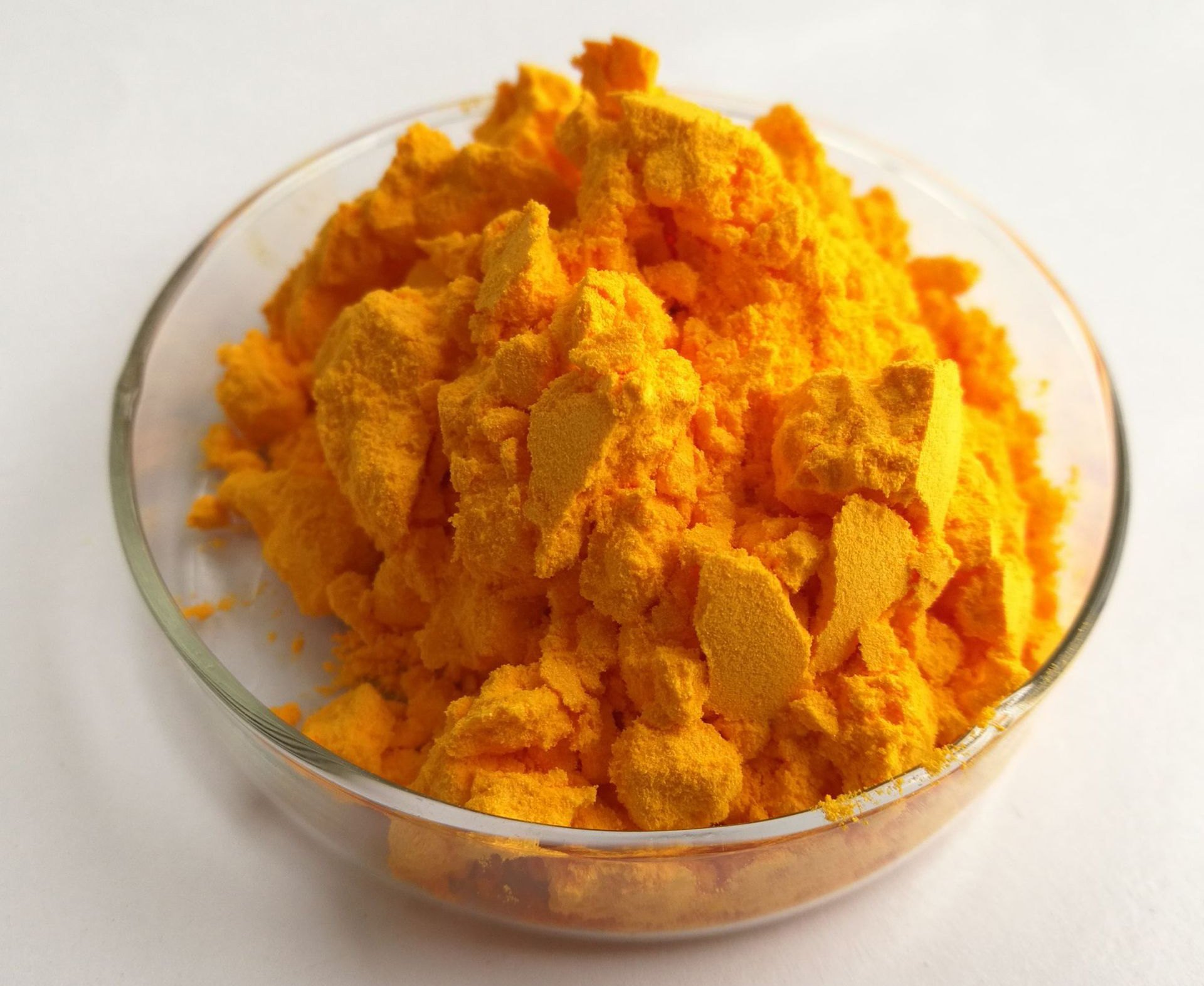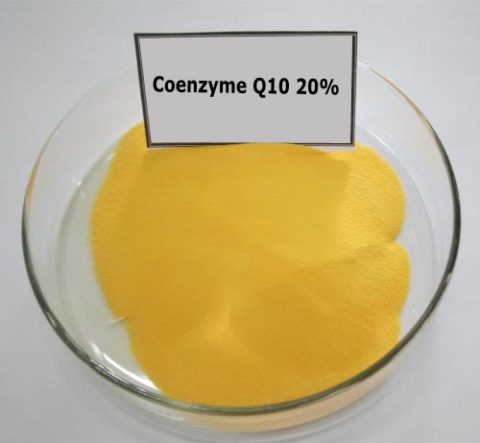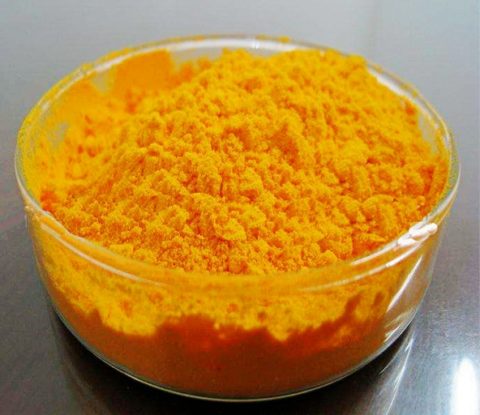
Coenzyme Q10 Powder, Ubiquinone, 10%, 20%(Water Soluble) , 98%(Fat Soluble) HPLC
Coenzyme Q is a kind of liposoluble quinones with side chains composed of different number (6-10) isoprene units. Its benzoquinone structure can be reversibly hydrogenated to hydroquinone. It's the hydrogen transporter in the respiratory chain. Coq in mammalian cells contains 10 isoprene units, so it is also called Q10. Coq can accept reduction of one e and one H + to semi quinone, and then accept reduction of one e and one H + to dihydroubiquinone. There are also three different forms of CoQ: oxidation, semi quinone and reductive, which transfer one or two electrons in the respiratory chain.
Coenzyme Q10, Ubiquinone Powder (Water-soluble/Fat-soluble)
【CAS No.】: 303-98-0
【Molecular formula】: C59H90O4
【Molecular weight】: 863.36
【Synonyms】: 2,3-Dimethoxy-5-Methyl-6-Decaprenylbenzoquinone
【Appearance】: Orange crystalline powder
【Specifications】: 10%, 20%(Water Soluble) , 98%(Fat Soluble) HPLC
【Standard】: Coenzyme Q10 USP34,CP2010, EP6, JP14 standard
【Benefits】: Anti-oxidation, restrains the formation and development of the atherosclerosis; prevent the tumor; adjust the immunization
【Packing】: Packed in 25 kg/fiber drum with double plastic bags inside
【Storage】: Store in a cool&dry place away from Moisture, Light, Oxygen
【Shelf Life】: 24 months since the manufacturing date

Coenzyme Q10, also known as ubiquinone, ubidecarenone, and abbreviated at times to Coenzyme Q10, CoQ, or Q10 is a coenzyme that is ubiquitous in the bodies of most animals. It is a 1,4-benzoquinone, where Q refers to the quinone chemical group and 10 refers to the number of isoprenyl chemical subunits in its tail.
This fat-soluble substance, which resembles a vitamin, is present in most eukaryotic cells, primarily in the mitochondria. It is a component of the electron transport chain and participates in aerobic cellular respiration, which generates energy in the form of ATP. Ninety-five percent of the human body’s energy is generated this way. Therefore, those organs with the highest energy requirements—such as the heart, liver, and kidney—have the highest Coenzyme Q10 concentrations.( Okamoto, T; Matsuya, T; Fukunaga, Y; Kishi, T; Yamagami, T (1989). “Human serum ubiquinol-10 levels and relationship to serum lipids”. International journal for vitamin and nutrition research. Internationale Zeitschrift fur Vitamin- und Ernahrungsforschung. Journal international de vitaminologie et de nutrition 59(3): 288–92. PMID 2599795.)
There are three redox states of Coenzyme Q10: fully oxidized (ubiquinone), semiquinone (ubisemiquinone), and fully reduced (ubiquinol). The capacity of this molecule to act as a 2 electron carrier (moving between the quinone and quinol form) and 1 electron carrier (moving between the semiquinone and one of these other forms) is central to its role in the electron transport chain, and as radical-scavenging antioxidant.
Functions and Applications
Coenzyme Q10 is not approved by the U.S. Food and Drug Administration (FDA) for the treatment of any medical condition. It is sold as a dietary supplement. In the U.S., supplements are not regulated as drugs, but as foods. How it is manufactured is not regulated and different batches and brands may vary significantly.(White, J. (lead reviewer); National Cancer Institute (NCI) (14 May 2014). “PDQ® Coenzyme Q10”. NCI, National Institutes of Health, U.S. Dept. of Health and Human Services. Retrieved 29 June 2014.)
A 2004 laboratory analysis by ConsumerLab.com of Coenzyme Q10 supplements on the market found that some did not contain the quantity identified on the product label. Amounts varied from “no detectable Coenzyme Q10”, to 75% of stated dose, and up to a 75% excess. Generally, it is well tolerated. The most common side effects are gastrointestinal symptoms (nausea, vomiting, appetite suppression, and stomachache), rash, and headache.
Heart disease
A 2014 Cochrane Collaboration meta-analysis found “no convincing evidence to support or refute” the use of Coenzyme Q10 for the treatment of heart failure. Evidence with respect to preventing heart disease in those who are otherwise healthy is also poor.(Madmani, M.E.; Yusuf Solaiman, A.; Tamr Agha, K.; Madmani, Y.; Shahrour, Y.; Essali, A.; Kadro, W. (2 June 2014). “Coenzyme Q10 for heart failure”. Heart Group. Cochrane Database of Systematic Reviews (John Wiley & Sons) (6): Art. no. CD008684. doi:10.1002/14651858.CD008684.pub2 – via The Cochrane Library.)
Another 2014 study of 420 patients in 17 patient centers over 7 years found that it “improves symptoms, and reduces major adverse cardiovascular events” after 106 weeks. A 2009 Cochrane review concluded that studies looking at the effects of Coenzyme Q10 on blood pressure were unreliable, and therefore no conclusions could be made regarding its effectiveness in lowering blood pressure.(Ho, MJ; Bellusci, A; Wright, JM (Oct 7, 2009). “Blood pressure lowering efficacy of coenzyme Q10 for primary hypertension.”. The Cochrane database of systematic reviews (4): CD007435. doi:10.1002/14651858.CD007435.pub2.PMID 19821418.)
Huntington’s disease
Available evidence suggests that “Coenzyme Q10 is likely ineffective in moderately improving” the chorea associated with Huntington’s disease.(Armstrong, MJ; Miyasaki, JM (Aug 7, 2012). “Evidence-based guideline: pharmacologic treatment of chorea in Huntington disease: report of the guideline development subcommittee of the American Academy of Neurology.”. Neurology(AmericanAcademy of Neurology) 79 (6): 597–603.)
Male infertility
While it can improve some measurements regarding sperm quality, there is no evidence that it increases live births or pregnancy rates(Lafuente, R; González-Comadrán, M; Solà, I; López, G; Brassesco, M; Carreras, R; Checa, MA (Sep 2013). “Coenzyme Q10 and male infertility: a meta-analysis.”.Journal of assisted reproduction and genetics 30 (9): 1147–56.).
Migraine headaches
Supplementation of Coenzyme Q10 has been found to have a beneficial effect on the condition of some sufferers of migraine. This is based on the theory that migraines are a mitochondrial disorder, and that mitochondrial dysfunction can be improved with Coenzyme Q10. The Canadian Headache Society guideline for migraine prophylaxis recommends, based on low-quality evidence, that 300 mg of Coenzyme Q10 be offered as a choice for prophylaxis.(Pringsheim T, Davenport W, Mackie G, et al. (March 2012). “Canadian Headache Society guideline for migraine prophylaxis”. Can J Neurol Sci 39 (2 Suppl 2): S1–59. PMID 22683887.)
Statin myopathy
Coenzyme Q10 has been routinely used to treat muscle breakdown associated as a side effect of use of statin medications. However, evidence from randomized controlled trials does not appear to support the idea that it is an effective treatment for statin myopathy.(Banach M, Serban C, Sahebkar A, Ursoniu S, Rysz J, Muntner P, Toth PP, Jones SR, Rizzo M, Glasser SP, Lip GY, Dragan S, Mikhailidis DP (January 2015). “Effects of coenzyme Q10 on statin-induced myopathy: a meta-analysis of randomized controlled trials”. Mayo Clin Proc (Systematic Review and Meta-Analysis). Lipid and Blood Pressure Meta-analysis Collaboration Group 90 (1): 24–34. doi:10.1016/j.mayocp.2014.08.021. PMID 25440725.)
Cancer
No large well-designed clinical trials of Coenzyme Q10 in cancer treatment have been done. The National Cancer Institute identified issues with the few, small studies that have been done stating, “the way the studies were done and the amount of information reported made it unclear if benefits were caused by the Coenzyme Q10 or by something else”. The American Cancer Society has concluded, “Coenzyme Q10 may reduce the effectiveness of chemo and radiation therapy, so most oncologists would recommend avoiding it during cancer treatment.”(“Coenzyme Q10”. American Cancer Society. Retrieved 20 February 2014.)
Dental disease
A review study has shown that there is no clinical benefit to the use of Coenzyme Q10 in the treatment of periodontal disease. Most of the studies suggesting otherwise were outdated, focused on in-vitro tests, had too few test subjects and/or erroneous statistical methodology and trial set-up, or were sponsored by a manufacturer of the product.(Wilkinson, EG; Arnold, RM; Folkers, K (1976). “Bioenergetics in clinical medicine. VI. adjunctive treatment of periodontal disease with coenzyme Q10“.Research communications in chemical pathology and pharmacology 14 (4): 715–9.PMID 785563.)
Parkinson’s disease
A 2011 review by the Cochrane Collaboration suggesting Coenzyme Q10 supplementation might benefit people with Parkinson’s disease was subsequently withdrawn from publication following a review by independent editors.(Liu J, Wang LN, Zhan SY, Xia Y (2012). “WITHDRAWN: Coenzyme Q10 for Parkinson’s disease”. Cochrane Database Syst Rev 5: CD008150.)




